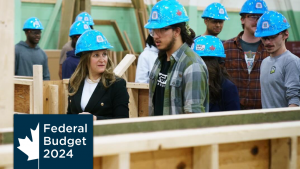Actions speak louder than words. Yet, what we hear from world leaders concerning climate change is mostly words about more action.
There has never been a more pressing issue than global warming and its impact on our planet’s future. However, the world has been treated to a revolving door of GHG reduction targets and future funding commitments, which are repeated again when they fall short. Given the 40 per cent contribution to global greenhouse gases (GHGs) from construction and buildings, can the industry afford to wait for definitive action from our governments?
This new column will look at ways construction and building operations can be proactive towards the goal of reducing GHGs, and how parties throughout the project decision chain can work with those levels of government willing to act.
There are good examples of positive action out there.
According to a report from Bloomberg, “Twenty-five major U.S. cities are on track to collectively reduce their greenhouse gas emission by 32 per cent by 2025 — surpassing international climate agreement goals.”
In Canada, Toronto, Vancouver and Hamilton have adopted stringent energy-efficiency initiatives to combat GHG emissions. Five hundred other municipal and regional jurisdictions have declared a climate emergency.
With Canada having the third highest GHG emissions per person in the world, what more motivation does the country’s building industry need to take action?
At the same time, multiple advances have been made in materials, design, construction and operational processes that can measurably reduce GHGs emissions. However, there are several bottlenecks for progress.
For example, building codes for both new and existing structures lag behind current knowledge and understanding of building science. The 2020 National Building Code is very late, now not expected until the spring of 2022. Development of Canada’s Altered Existing Building code, currently managed by volunteer committees, may take nine years to complete. Both lack federal ministry accountability. And while provinces and municipalities are developing their own codes aimed at higher standards, they cry out for harmonization across jurisdictions.
That isn’t to say Canada lacks organizations and individual companies enthusiastic about doing what is clearly the right thing. What appears to be missing are two components: co-ordinated action by all groups working together and a federal government willing to take positive actions.
As sustainability consultant Julie Godefroy writes, “There is a plethora of resources and industry enthusiasm. To bring all this together into consistent standards, to reach the whole industry fast, and to avoid penalizing market leaders, regulation is needed.”
However, there is still a lot Canada’s construction industry can do in the meantime.
Analytical tools like SeeFar are available to designers to show owners how taking an efficiency-first approach to new projects or major retrofits delivers a strong and predictable financial payback beyond the obvious environmental benefits. Designers, builders and contractors working together can also carry out embodied carbon assessments of material procurement, assembly and construction processes.
Canada is not alone in its conflict between those in the industry who want to design, build and operate better, and the obvious legislative vacuum. We can look across the Atlantic to the U.K. where similar calls for government action can be heard.
Canada’s building industry could do well to embrace the encouragement of Colin Wood, chief executive of AECOM Europe.
“The scale of the challenge requires everyone to play their part, bringing their best skills and talent to the table,” Wood recently wrote in building.co. “It is our industry that will need to provide many of the solutions to rapidly support clients and communities on their journeys to net-zero. Without doubt, the greatest impact will be felt through our collaborative and widespread action.”
In other words, while pressure must be placed on federal and provincial politicians to take the actions needed to back up their words, the construction industry does not have to wait.
Of all individuals to speak to that point, it is somewhat ironic to read HRH Prince Charles’ op-ed in a recent issue of the Globe and Mail.
“For me, the private sector holds the key. I am not sure we are listening to them enough.”
John Bleasby is a Coldwater, Ont.-based freelance writer. Send comments and Climate and Construction column ideas to editor@dailycommercialnews.com











Recent Comments
comments for this post are closed